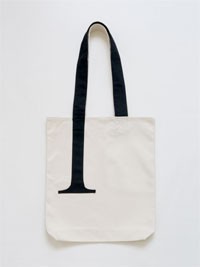 I quite like this serif tote bag…
I quite like this serif tote bag…
 I quite like this serif tote bag…
I quite like this serif tote bag…
 There have been lots of things to do on my visit to Vermont, but one of the more unique was the Bread and Puppet Theater, a performance group in Glover. All summer they have performances on Friday evening and Sunday afternoons, and their museum of puppets is open every day. They bill themselves as “cheap art and political theater in Vermont.” The puppets — mostly huge and inventive heads — are quite amazing. This photo and this one give you an idea of the size of the puppets and the heads.
There have been lots of things to do on my visit to Vermont, but one of the more unique was the Bread and Puppet Theater, a performance group in Glover. All summer they have performances on Friday evening and Sunday afternoons, and their museum of puppets is open every day. They bill themselves as “cheap art and political theater in Vermont.” The puppets — mostly huge and inventive heads — are quite amazing. This photo and this one give you an idea of the size of the puppets and the heads.
![]() They also house a press that publishes small books (such as “how to make a papier-mâché puppet”), posters and calendars. To the left is a display in the museum of one of the puppets printing a broadside. Below is a table of their broadsides and a sign that quite nicely sums up the philosophy of their books.
They also house a press that publishes small books (such as “how to make a papier-mâché puppet”), posters and calendars. To the left is a display in the museum of one of the puppets printing a broadside. Below is a table of their broadsides and a sign that quite nicely sums up the philosophy of their books.
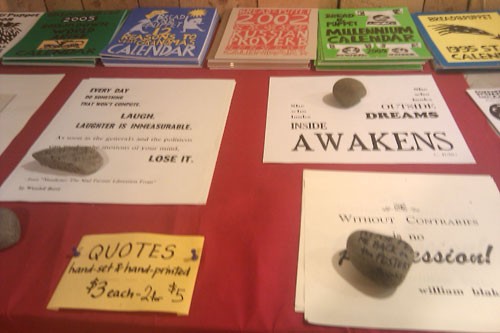
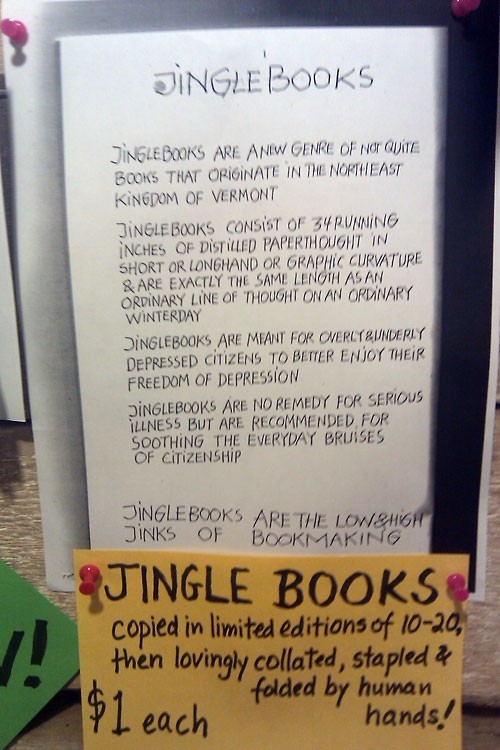
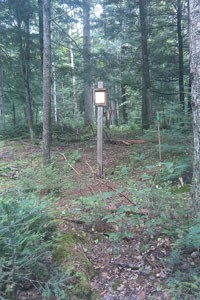 One of the walking trails near my sister’s house in Vermont has a series of sign posts with a changing collection of local poetry. I liked that the posts, like the one pictured to the left, are off the path a bit, so you have to look for them. And I especially enjoyed the poem below, contrasting the east and west coasts.
One of the walking trails near my sister’s house in Vermont has a series of sign posts with a changing collection of local poetry. I liked that the posts, like the one pictured to the left, are off the path a bit, so you have to look for them. And I especially enjoyed the poem below, contrasting the east and west coasts.
New England Winter
Paul Mariani
To hell with John Greenleaf Whittier
and his chirpy snowfall odes. Snow.
We’ve had our share: 18 storms thus far,
ice layered like so much sandstone shale.
A regular archaeologist’s dig.
All the television graphics show
this at least: a winter made in hell.
Each day now proud old records fall,
to be replaced by miserable new ones.
What fun it is to sit here counting
off minus 30 mornings, these glittering
kitchen pipes festooned with ice.
On the upside, take the Angelinos after
last month’s quake, fear mounting
with the mounting Richter Sale,
the decibels revised upward. Twice.
“Maybe, but I’ll still take the quake’s
twenty seconds to your hundred-day
glacial siege. Anytime.” Thus my
California sister, who can be tough.
What hours, days, I have spent
reading the West Coast fault lines from L.A.
on up, all the way to the Aleutian chain.
“At least we’re built on firmer stuff.”
I feel myself edging to a crushing
rejoinder, this once vindicated. But by then
she’s off the phone, no doubt
outdoors already, tanning on that delicious
cedar-toasted deck of hers which gazes
so serenely out over the Pacific Ocean.
While here am I, iced-over & snowed under,
blinking out this frozen glass. At this.
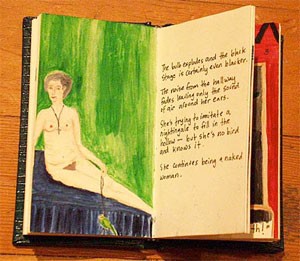 As a follow-up on my recent post on Jeannine Stein’s thoughts on what bookmaking means to her, I’ve been looking for comments by other bookmakers. I ran across a set of interviews from 2000, in the journal How 2 called Livres de Poètes: Six poets talk about the books they make. The interviewer, poet and book artist Dale Going, says: "In co-curating, with Jaime Robles, an exhibition in June 2000 at the Berkeley Arts Center called Livres de poètes (femme), I’ve had the pleasure of reading, handling, looking at, experiencing about a hundred such handmade books by poet/book artists whose work balances on the textual/visual cusp. I talked with six artists whose work covers a range of methods, techniques, and intentions." (entire intro to the interviews here.) The poets/bookmakers she interviewed are:
As a follow-up on my recent post on Jeannine Stein’s thoughts on what bookmaking means to her, I’ve been looking for comments by other bookmakers. I ran across a set of interviews from 2000, in the journal How 2 called Livres de Poètes: Six poets talk about the books they make. The interviewer, poet and book artist Dale Going, says: "In co-curating, with Jaime Robles, an exhibition in June 2000 at the Berkeley Arts Center called Livres de poètes (femme), I’ve had the pleasure of reading, handling, looking at, experiencing about a hundred such handmade books by poet/book artists whose work balances on the textual/visual cusp. I talked with six artists whose work covers a range of methods, techniques, and intentions." (entire intro to the interviews here.) The poets/bookmakers she interviewed are:
Lisa Kokin (her website)
"I don’t just make books: I also make sculpture and installation art…"
Emily McVarish (more of her work)
"I’ve been really interested in the three-dimensional and mechanical aspects of reading and poetics…"
Denise Newman
"I began making books over a series of summers spent writing on the Danish island of Bornholm…"
Eléna Rivera (website with her poetry)
"I used to write and make books as a child, so for me, making letterpress books was a rediscovery of book making…"
Jaime Robles (read some of her poetry)
"I started working with books when I was fairly young; in college I majored in both English and art…"
Meredith Stricker (one of her books, Alphabet Theater, and see part of the book on GoogleBooks)
"Thinking about my own history of writing, it has become clear to me that it’s not that there was poetry and then there were books; the materials and objects were the poetry…"
I’m still in Vermont, and while we’ve been here, no matter where we go, my sister seems to want to stop at every antique shop, barn and garage sale along the way. I must confess there’s usually nothing of interest for me, but much that would suit her Victorian-era house. In particular she’s been looking for some extra chairs for her dining room as well as frames for some old maps she’s acquired. Yesterday we went to a large estate sale and had an unexpected find, something even I was enamored with! It was a small pile labeled “Beatrice’s Life, $10” and included 3 large, framed diplomas, several photographs of Beatrice, and what looked like a school workbook. While my sister examined the frames, I idly picked up the book — and out fell a folded piece of paper and a small leather pouch. The workbook, with the title page “History of Vermont, ’26,” was full of beautiful handwriting and hand-drawn maps of Vermont. The folded piece of paper turned out to be a series of maps of Vermont.
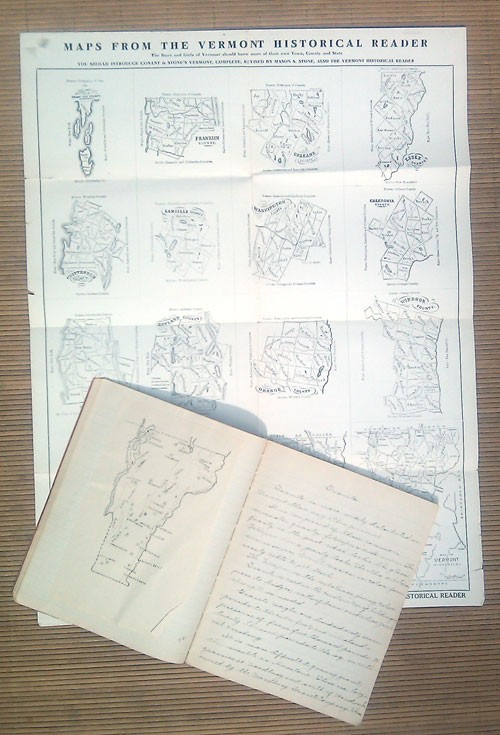
As my sister pulled out the tape measure to check the frame sizes, I opened the little pouch. It measures 2×1-1/2″ and contains tiny calling cards (1-5/8×7/8″) with just a name on them.
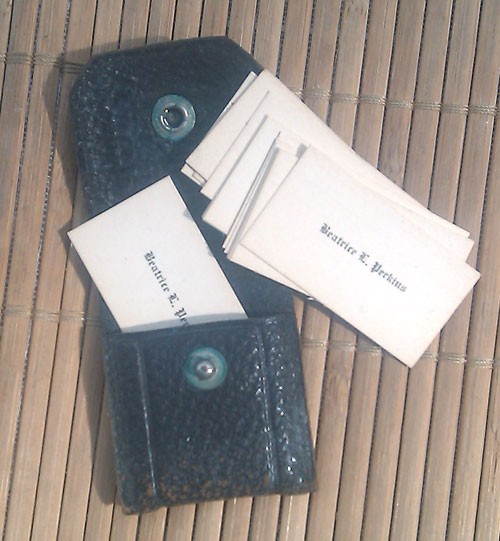
The frames were just what my sister was looking for, so off we went with the whole package. Once we got back home, I examined the workbook in detail. At the bottom of the large map, it says “The Sheet and County of State Maps for blackboard exercises, taken from the NEW VERMONT HISTORICAL READER furnished free with every copy of the book… Every pupil should have one. The sheets can be mounted on cardboard or enlarged by the scholar. The teacher can require villages, mountains, roads, etc., to be marked in each town, so as to get the pupil familiar with his own locality county and state.” The workbook, dated 1926, was the result of these blackboard exercises. The New York Public Library has digitized the 1903 version of The Vermont Historical Reader And Lessons on the Geography of Vermont, with Notes on Civil Government.
![]() Of the diplomas in the frames — one was for finishing an advanced course of the Palmer Method of Business Writing, where she was awarded a “Certificate for Superior Ability in Rapid Muscular Movement Commercial Penmanship.”
Of the diplomas in the frames — one was for finishing an advanced course of the Palmer Method of Business Writing, where she was awarded a “Certificate for Superior Ability in Rapid Muscular Movement Commercial Penmanship.”